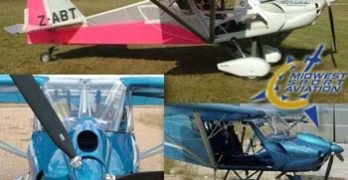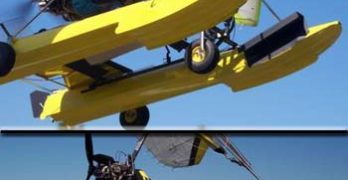If you study FAA’s registration database as I do, you’ll quickly discover that Flight Design and its various CT models have a strong presence in the USA (the world for that matter, with 1,500 flying, according to the company). Since CT was first certified in April 2005 — the second LSA to win Special LSA certification, after Evektor’s SportStar — the German brand has steadily planted CTs across America. You can see a CT at more airfields than any other brand by more than double; the next closest is the American Legend Cub. *** The accompanying graphic was created by Flight Design USA to show the locations of more than 300 CT aircraft in the United States. The distribution is surprisingly even with obvious concentrations in big aviation states such as Florida, California, and Texas/Oklahoma with another area of strength in New England, home base of the U.S.
Search Results for : search.cfm
Not finding exactly what you expected? Try our advanced search option.
Select a manufacturer to go straight to all our content about that manufacturer.
Select an aircraft model to go straight to all our content about that model.
Belite’s Carbon Fiber Part 103 Ultralight Vehicle
If you’ve been around aviation long enough you’ve heard the Q&A: “Know how to make a small fortune in aviation? Start with a large one!” Yet aviation can always use fresh talent, so welcome former tech entrepreneur, James Wiebe, turned aviation businessman. From his days building Mac peripherals under the name Newer Technology (and reaching sales of $60 million), Wiebe sold his tech enterprises and, in January 2009, bravely launched Belite Aircraft. The first flight came July 4th.
Wiebe chose to incorporate stronger, lighter carbon fiber technologies to replace steel, wood, and aluminum. The result is a three-axis, full-cockpit airplane with a full instrument panel that can be built to weigh less than Part 103’s 254-pound maximum. Though employing plenty of costly carbon fiber including on the firewall, Belite uses a welded steel frame for strength and safety. The premium Belite 254 CF includes carbon fiber wing spars and ribs, hydraulic brakes, aluminum wheels, full flight instrumentation, built in transceiver, a bigger 45-hp engine, enhanced electrical system, and a Gizmo GPS dock.
Pair of Floatplanes Announced: Legend and Remos
We’ve arrived at the end of the main float-flying season, but two of our largest Light-Sport Aircraft manufacturers just announced floatplane models. Welcome to the American Legend FloatCub and the Remos GX on floats. Each company contracted with float experts (a big difference from SeaMax or SeaRey). *** The most successful American LSA producer, American Legend won approval on October 2 for their Amphibious Legend FloatCub after declaring they met ASTM standards. FloatCub was put on sale for $159,000 and the first customer aircraft is being assembled. Legend went to long-established float company, Baumann Floats of New Richmond, Wisconsin. The new model flew in July, 2009 and made an appearance at Oshkosh. Unlike original Piper Cubs that were often put on floats, the Legend Cub has doors on both sides, a big benefit when docking. If purchased with the 120-hp Jabiru 3300, Legend FloatCub should prove quite energetic even at high elevations.
Making A Splash… in China: Ramphos Trident SLSA
A few years back I evaluated Ramphos. Now, the boat-hulled trike is our newest Special Light-Sport Aircraft amphibian — SLSA #102. Priced at less than $40,000 for the Rotax 582-powered version to something north of $50,000 for the four stroke Rotax 912 powerplant, this seaplane qualifies as a bargain. Ramphos Trident won its SLSA approval back in April 2009. *** In revealing this achievement, one of the most interesting points from U.S. partner Gil McGarity concerned a Ramphos entry to the potentially huge China market. “Just when things looked the darkest, what with spending all our money for the certifications and the recession starting with a vengeance, we were invited to China,” Gil recalled. “We struck a deal to help develop a line of weight-shift aircraft and train personnel to fly. We were given 10 young engineers trained in using the Katia CAD programs, two 747-sized hangars with state of the art paint rooms, composite labs, 5 and 7 axis CNC [machines], assembly areas and a seemingly endless stream of development funds.” To show how serious officials are about opening the gates to sport aircraft, Gil said authorities… “built a 500-meter asphalt runway for LSA craft very near us in Changsha.” He noted that very few if any recreational aviation runways exist in China.
Cheetah XLS Speeds through SLSA Approval — #101
Reaching SLSA model number 100 produced loads of media attention and a feeling of pride in reaching such a benchmark in less than five years. How do you follow that act? With SLSA #101, naturally. *** Welcome to the Cheetah from Rainbow Aircraft in South Africa, imported by Midwest Sport Aviation based in Wisconsin. While working on ASTM approval the Syvertson brothers sold a kit version. If this modestly priced SLSA is beyond your budget, the Amateur-Built kit can save $10-20,000. *** The ready-to-fly Cheetah represents one of the true bargains of the SLSA industry, priced at $52,950 for either trigear or taildragger models powered by the 85-hp Jabiru and delivered with a MGL radio, cloth-finished interior, and those cool swing-up armrests with built-in throttle on each side. Even well optioned, a fully-built SLSA Cheetah can stay under $60,000 and that’s the price some folks expected for Light-Sport Aircraft back when the rule was announced… so there you go.
Ultralight Trainers…Exemptions?…SLSA Trainers
Ah, sweet Part 103 ultralights. These lightest of powered aircraft have the least FAA regulation of any flying machine. A single piece of letter paper holds the entire rule. But how do you learn to safely fly a single seater? Oh, there’s the rub. *** Through January 31, 2010, two-seat ultralights converted to ELSA status may train pilots for hire. Then they must cease… maybe. Some feel that the nation lacks enough such trainers so Aero Sports Connection petitioned for an extension. Sounds reasonable. *** But what about companies that spent resources to win FAA approval? It sounds like those who played by the rules as FAA wished could miss their reward of taking over such training aircraft sales. The controversy has complications and you probably don’t want to read it all. *** But here’s what industry organization LAMA has to say: “In the 4.3 years since the first approval, 100 SLSA models have been approved.
LSA #100 Reached! …in Less Than Five Years
Triple digits! In five years the LSA industry has reached SLSA model #100. Actually, here’s another one that slipped by our radar. Info now shows SLSA #99 was the Krucker amphib trike named Cygnet and Van’s RV-12 was technically #100. Our SLSA List shows Special Light-Sport Aircraft in order of their approval. *** “We got our SLSA completed 3 July 2009,” wrote U.S. representative, Michael Percy, of XL Kites. This means the Cygnet he imports was approved a couple weeks earlier than the Van’s RV-12 on July 21st, which came one day after the fifth anniversary of the new rule announcement (July 20th, 2004). *** One hundred models approved in such a short time has no comparison in worldwide aviation history. In fact, reaching #100 only took 4.3 years because the first approval occurred on April 7th, 2005 …that’s two new models every single month!
SeaRey Reports Superb Oshkosh; Who Will Get #100?
We sit on the edge of hitting triple digits of Special Light-Sport Aircraft. Just before Oshkosh started, Van’s Aircraft announced their RV-12 qualified for SLSA airworthiness (which also allows the Oregon company to sell ELSA kits). People have started to ask, “Who will offer Number 100 SLSA?” One possibility is the SeaRey from Progressive Aerodyne. *** SeaRey marketing man, Darrell Lynds reported a spectacular Oshkosh event, “We sold 11 kit SeaRey aircraft (the LSX) and four SLSA versions to be called the SeaRey Sport.” That represents quite a performance, causing me to inquire what amount of money changed hands in order to call these an order. “We collected $5,000 toward a kit and $10,000 on a fully-built SLSA,” explained Darrell. I’d call that enough cash per airplane to make for genuine orders. *** I spoke with many sellers at Oshkosh who reported “very solid leads,” and “genuinely interested buyers,” but a few complained that despite these positive comments, they were not seeing the cash.
A First Look at Two New Tandem LSA
Here come the new tandems. And I do mean new! Suspending a full flight-trial regime, U.S.-based MySky took their new MS-1 on a long maiden voyage from Daytona Beach, Florida to Oshkosh 2009. And just yesterday, the Slovak Republic-based sportShark, from Shark.Aero, took its first flight. *** Tandems seat occupants fore and aft like some existing SLSA models but that’s where the similarities end. MS-1 and sportShark are clean-sheet designs aimed at performance and comfort, where all tandems presently approved are recreational aircraft. *** Other than the composite Sky Arrow*, all other seven tandems in the SLSA List are simpler, first-generation designs. All are fabric covered. None are speedsters. (Note: You can find all these qualities for any of the 99 SLSA models using PlaneFinder 2.0.) *** One and sportShark are second-generation designs. In both cases they were created after and because of the Light-Sport rules and ASTM industry-standards certification.
‘Round the World LSA Flight Arrives in Oshkosh
For most pilots flying 100 hours represents a decent year of enjoying aviation. Mike Blyth and James Pitman hit that on the first long leg of their ’round the world flight, traversing a huge expanse of ocean en route from South Africa to Oshkosh. Their total flight will see each logging nearly 250 hours of flying… in a month! *** The intrepid duo successfully arrived at AirVenture Oshkosh right on schedule. After spending a few days at this “Disneyland for Airplanes,” the pair of global adventurers will set off for California, Hawaii and the far east as they wing their way back to what should be a heroes’ welcome in South Africa. Blyth has accomplished several impressively long flights and has made movies about the experience. He and Pitman will repeat with “Sling 2009 Around the World” aerial expedition. These are no mere “There I was…” films.
- « Previous Page
- 1
- …
- 5
- 6
- 7
- 8
- 9
- …
- 12
- Next Page »











